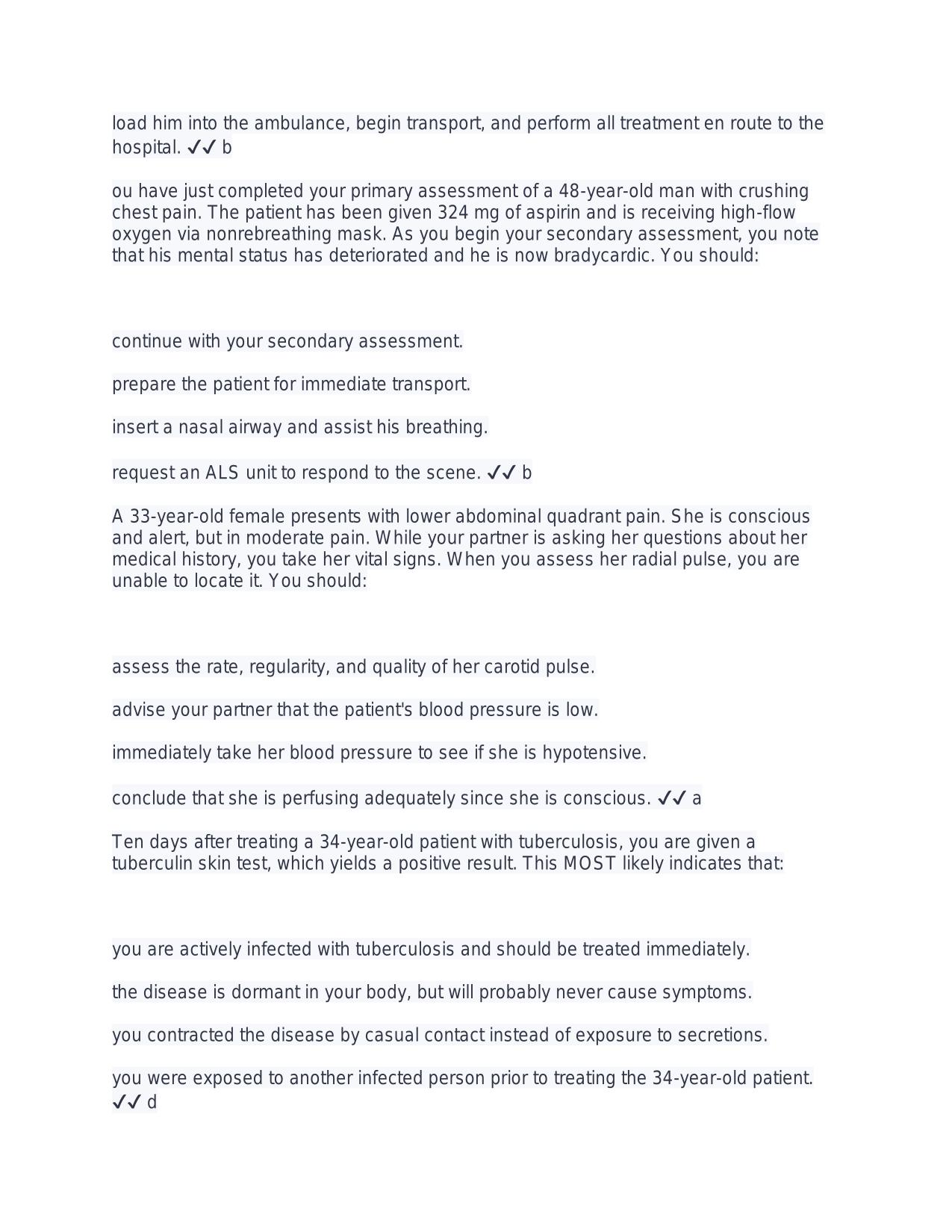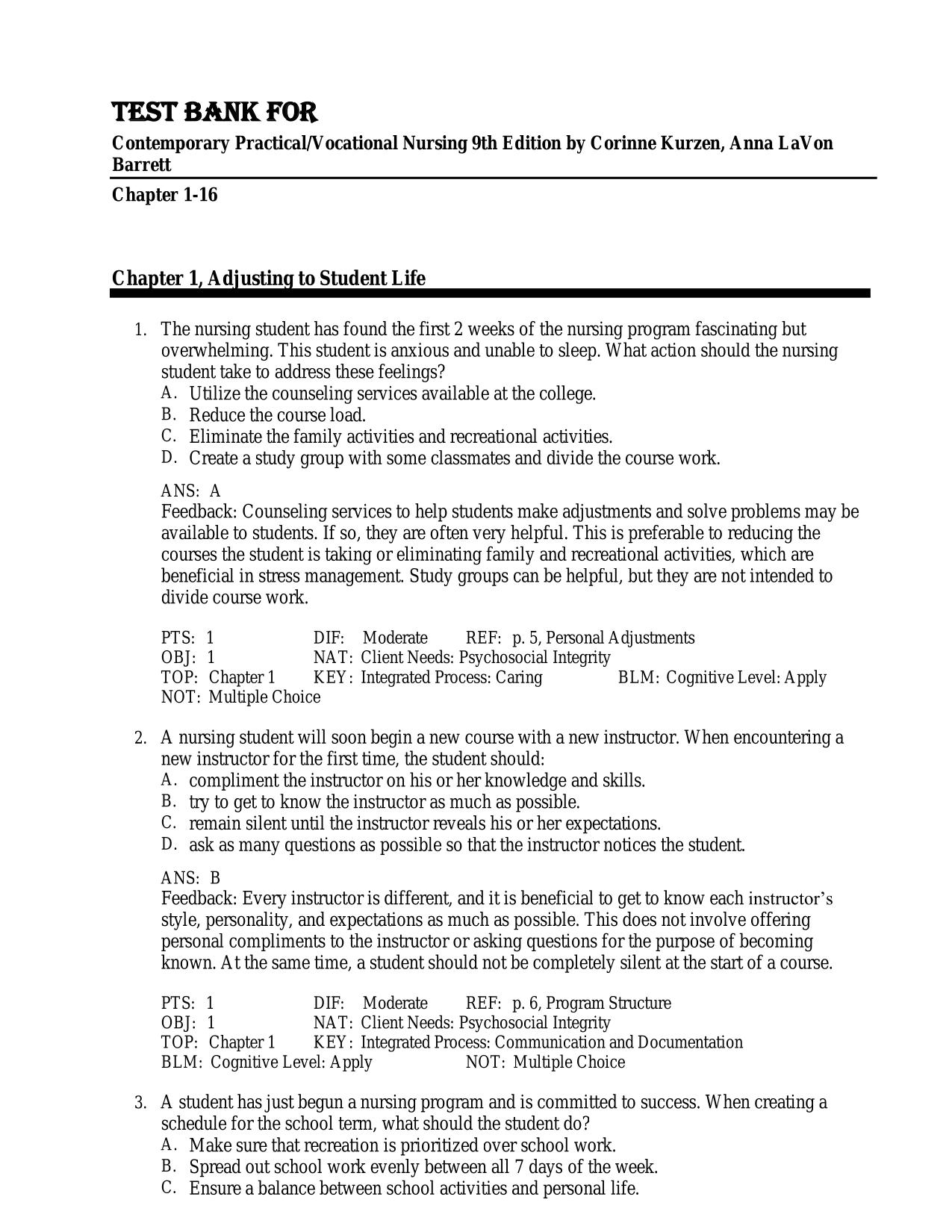EMT FISDAP READINESS EXAM 4 ACTUAL 2025/2026 LATEST UPDATE
Course:
EMT FISDAP
Institution:
EMT FISDAP
EMT FISDAP READINESS EXAM 4 Questions and Answers (2024/2025) (Verified Answers) In contrast to the assessment of a trauma patient, assessment of a medical patient: almost exclusively focuses on physical signs that indicate the patient is experiencin...
After purchase, you get:
✅ Instant PDF Download
✅ Verified answer explanations
✅ Refund if not Satisfied
✅ Prepared for 2025/2026 test cycle
Document Information
| Uploaded on: | November 1, 2025 |
| Last updated: | November 1, 2025 |
| Number of pages: | 35 |
| Written in: | 2025/2026 |
| Type: | Exam (elaborations) |
| Contains: | Questions & Answers |
| Tags: | EMT FISDAP READINESS EXAM 4 Questions and Answers (2024/2025) (Verified Answers) In contrast to the assessment of a trauma patient, assessment of a medical patient: almost exclusively focuses on physical signs that indicate the patient is experiencing a problem. is focused on the nature of illness, the patient's chief complaint, and his or her symptoms. requires a thorough head-to-toe exam that involves a detailed assessment of all body systems. is not as complex for the EMT because most patients typically present with classic symptoms. ✔✔ b Which of the following statements regarding medical emergencies is correct? Medical emergencies always take priority over traumatic injuries. Medical emergencies can appear to be trauma in nature. Medical emergencies and traumatic injuries always have distinctive presentations. Medical emergencies rarely precipitate traumatic injuries. ✔✔ b You and your EMT partner arrive at the residence of a 50-year-old man who complains of weakness. Your primary assessment reveals that he is critically ill and will require aggressive treatment. The closest hospital is 25 miles away. You should: perform a detailed secondary assessment, assess his vital signs, and then transport rapidly. manage all threats to airway, breathing, and circulation and consider requesting an ALS unit. administer oxygen via nonrebreathing mask and obtain as much of his medical his |
Seller Information

AdelineJean
User Reviews (0)
Exam (Elaborations)
$9.50
Add to Cart
100% satisfaction guarantee
Refund Upon dissatisfaction
Immediately available after purchase
Available in Both online and PDF
$9.50
| 0 sold
Discover More resources
Content Preview
EMT FISDAP READINESS EXAM 4 Questions and Answers (2024/2025) (Verified Answers) In contrast to the assessment of a trauma patient, assessment of a medical patient: almost exclusively focuses on physical signs that indicate the patient is experiencing a problem. is focused on the nature of illness, the patient's chief complaint, and his or her symptoms. requires a thorough head-to-toe exam that involves a detailed assessment of all body systems. is not as complex for the EMT because most patients typically present with classic symptoms. ✔✔ b Which of the following statements regarding medical emergencies is correct? Medical emergencies always take priority over traumatic injuries. Medical emergencies can appear to be trauma in nature. Medical emergencies and traumatic injuries always have distinctive presentations. Medical emergencies rarely precipitate traumatic injuries. ✔✔ b You and your EMT partner arrive at the residence of a 50-year-old man who complains of weakness. Your primary assessment reveals that he is critically ill and will require aggressive treatment. The closest hospital is 25 miles away. You should: perform a detailed secondary assessment, assess his vital signs, and then transport rapidly. manage all threats to airway, breathing, and circulation and consider requesting an ALS unit. administer oxygen via nonrebreathing mask and obtain as much of his medical history as possible. load him into the ambulance, begin transport, and perform all treatment en route to the hospital. ✔✔ b ou have just completed your primary assessment of a 48-year-old man with crushing chest pain. The patient has been given 324 mg of aspirin and is receiving high-flow oxygen via nonrebreathing mask. As you begin your secondary assessment, you note that his mental status has deteriorated and he is now bradycardic. You should: continue with your secondary assessment. prepare the patient for immediate transport. insert a nasal airway and assist his breathing. request an ALS unit to respond to the scene. ✔✔ b A 33-year-old female presents with lower abdominal quadrant pain. She is conscious and alert, but in moderate pain. While your partner is asking her questions about her medical history, you take her vital signs. When you assess her radial pulse, you are unable to locate it. You should: assess the rate, regularity, and quality of her carotid pulse. advise your partner that the patient's blood pressure is low. immediately take her blood pressure to see if she is hypotensive. conclude that she is perfusing adequately since she is conscious. ✔✔ a Ten days after treating a 34-year-old patient with tuberculosis, you are given a tuberculin skin test, which yields a positive result. This MOST likely indicates that: you are actively infected with tuberculosis and should be treated immediately. the disease is dormant in your body, but will probably never cause symptoms. you contracted the disease by casual contact instead of exposure to secretions. you were exposed to another infected person prior to treating the 34-year-old patient. ✔✔ d Which of the following statements regarding the human immunodeficiency virus (HIV) is correct? HIV is far more contagious than hepatitis B and is easily transmitted in the health care setting. The risk of HIV infection is high, even if an infected person's blood comes in contact with your intact skin. The risk of HIV infection is greatest when deposited on a mucous membrane or directly into the bloodstream. Most patients who are infected with HIV experience chronic symptoms that vary in duration and severity. ✔✔ c A 58-year-old man complains of chest discomfort and nausea. He is conscious and alert. His blood pressure is 140/90 mm Hg, his pulse is 104 beats/min, and his respirations are 16 breaths/min. Your partner has applied supplemental oxygen. Prior to assisting the patient with one of his prescribed nitroglycerin tablets, you ask him if he takes medication to treat erectile dysfunction and he tells you that he does. You should: avoid giving him nitroglycerin and transport him at once. ask him what he takes, how much, and when he last took it. recall that medications for erectile dysfunction can cause hypertension if given with nitroglycerin. administer his nitroglycerin and then reassess his blood pressure. ✔✔ b Your primary assessment of an elderly woman reveals that she is conscious and alert, but she is experiencing difficulty breathing. She has a history of emphysema, hypertension, and congestive heart failure. As you assess the patient's circulatory status, you should direct your partner to: perform a head-to-toe secondary assessment. assess her oxygen saturation and blood pressure. retrieve the stretcher and prepare for transport. administer oxygen with the appropriate device. ✔✔ d Which of the following is MOST characteristic of adequate breathing? 22 breaths/min with an irregular pattern of breathing and cyanosis 20 breaths/min with shallow movement of the chest wall and pallor 24 breaths/min with bilaterally equal breath sounds and pink skin 30 breaths/min with supraclavicular retractions and clammy skin ✔✔ c You are dispatched to a residence for a 67-year-old female who was awakened by shortness of breath and sharp chest pain. Her husband tells you that she was recently discharged from the hospital after having hip surgery. Your assessment reveals dried blood around her mouth, facial cyanosis, and an oxygen saturation of 88%. This patient's presentation is MOST consistent with: acute pulmonary edema. right-sided heart failure. acute pulmonary embolism. spontaneous pneumothorax. ✔✔ c Which of the following statements regarding anaphylaxis is correct? Patients with asthma are at lower risk of developing anaphylaxis. Anaphylaxis is characterized by airway swelling and hypotension. Most anaphylactic reactions occur within 60 minutes after exposure. The signs of anaphylaxis are caused by widespread vasoconstriction. ✔✔ b A 59-year-old male with a history of emphysema complains of an acute worsening of his dyspnea and pleuritic chest pain following a forceful cough. Your assessment reveals






